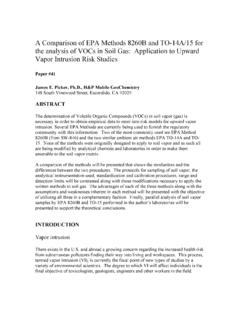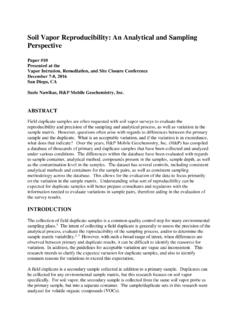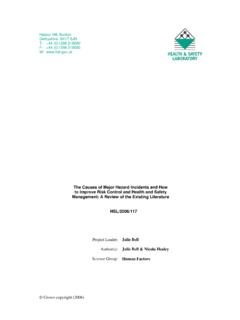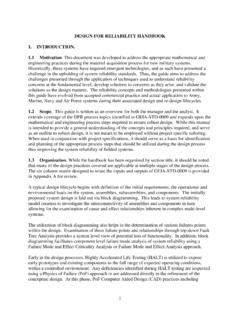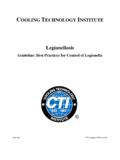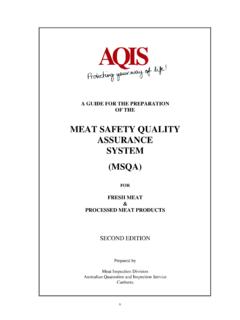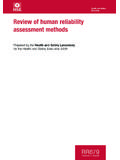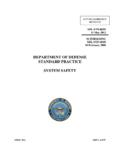Transcription of Section 5 Site Investigation Techniques - H&P Mobile ...
1 SAM 5-1 Section 5 site InvestigationTechniquesI. INTRODUCTIONC onsistent and appropriate site Investigation Techniques must be used to ensure that accurate, reliable,and representative data are collected during the site assessment process. The following guidance isprovided to establish standardized methods and procedures for the Investigation , testing, andinterpretation of geology, hydrogeology, and contaminant mobility. This Section is not intended toduplicate well-established methods and procedures, but to establish minimum standards for properinvestigation Techniques at a contaminated Investigation Techniques include soil and rock sampling, soil vapor sampling, direct measurementof vapor flux, groundwater sampling, laboratory analysis, and stockpile sampling.
2 Additionalguidance on standard field and laboratory methods can also be found in many textbooks, governmentagency documents, and professional society publications. A list of references for various topics isprovided in Appendix BORING AND WELL PERMITSP ermits are required for all groundwater, vadose wells, cathotic protection wells, and for manyexploratory borings (San Diego County Code, Title 6, Division 4). Standards for well construction,destruction, reconstruction, or repair are as stated in California Department of Water ResourcesBulletins 74-81 and 74-90. More specific boring and well construction standards are presented inAppendix An explanation of permit requirements is provided below.
3 Completed permitapplications must be submitted to the San Diego County Department of Environmental Health(DEH), and approval must be received before drilling can San Diego County, a well includes: Community supply wells, Individual domestic wells, Commercial supply wells, Industrial supply wells, Agricultural supply wells, Cathodic protection wells, Groundwater monitoring wells (observation wells and piezometers), Groundwater remediation wells,In This Section :Introduction5-1 Boring and Well Permits5-1 Soil and Rock Sampling5-8 Soil Vapor Sampling5-14 Direct Measurement of Vapor Flux5-27 Well Development5-29 Well Purging and Sampling5-31 Residual Saturation5-45 Soil Leachability5-51 Laboratory Analysis5-53 Waste Characterization5-61 Section 5: site Investigation TECHNIQUESPage SAM Manual Vadose monitoring wells, (vapor wells, gas monitoring wells, vapor probes), Vapor extraction/inlet wells, and Borings (test holes, auger holes, driven test holes, cone penetrometer test holes, SiteCharacterization and Analysis Penetrometer System [SCAPS] test holes, geotechnicalborings, etc.)
4 A. Permit Requirements1. Groundwater, Vadose, and Cathodic Protection WellsWell permits are required for any groundwater, vadose, or cathodic protection wellinstallation regardless of how the well is installed. Information on the construction anddestruction methods and specific permitting requirements for cathodic protection wells can befound on the San Diego County website at the Monitoring Well Program page( ).2. Exploratory or Test Borings and Geotechnical BoringsWell permits are required on all sites for: Any boring in which a casing will be installed Any boring that has a monitoring device installed Any soil boring greater than 20 feet in depth Any soil boring, 20 feet or less in depth, where the groundwater table is anticipated to beencounteredIn areas where hazardous waste or hazardous materials have not been stored, are not nowstored, are not proposed to be stored; or where soil and groundwater contamination is notknown or suspected, a permit may be waived after review by DEH.
5 For this determinationsubmit a detailed site map and a description of the proposed work to assist in the Well DestructionWell permits are required for destruction of any groundwater, vadose, or cathodic Well ReconstructionWell permits are required for reconstruction of any groundwater, vadose, or cathodicprotection well. Minor modifications may be completed without a permit but must beapproved by DEH before work is Permit ApplicationSubmit three (3) copies of a complete Permit Application for Groundwater and VadoseMonitoring Wells and Exploratory or Test Borings (well/boring application), detailed site plan,additional supporting documents (if required), and the appropriate fees.
6 A copy of thewell/boring application is available in Appendix DEH will not process the application untilall fees are submitted. At least one of the application copies must have original signatures ofSECTION 5: site Investigation TECHNIQUESSAM 5-3both the driller and the Registered Geologist (RG), Registered Civil Engineer (RCE), CertifiedEngineering Geologist (CEG), or Certified Hydrogeologist (CHG). Please allow seven to ten (7to 10) working days for processing and an incomplete application is submitted, the permit will be disapproved and returned to theapplicant for correction and resubmittal. A time frame will be established for modifying theapplication for contact person indicated on the well/boring application will be notified when the applicationis approved or disapproved.
7 At that time arrangements will be made to have the permit picked upat the DEH office or mailed to the address indicated on the ApplicationComplete the Permit Application for Groundwater and Vadose Monitoring Wells andExploratory or Test Borings. The following information must be included on Assessor s parcel number (APN)b. Current property ownerc. C57 driller's name doing work (All work must be done by a properly licensed and bondedcontractor.)d. Registered Geologist or Civil Engineer on projecte. Number of wells (or borings) to be constructedf. Well typeg. Drilling methodh. Proposed materials to be usedi. Proposed well constructionj.
8 Driller s signature (must have original signature)k. Original signature of Registered Geologist (RG), Registered Civil Engineer (RCE),Certified Engineering Geologist (CEG), or Certified Hydrogeologist (CHG)l. Evidence of a $2,500 bond, posted with the San Diego County Department ofEnvironmental Healthm. detailed site plan (drawn to scale) showing the location of the proposed well(s) and/orboring(s) and the location of existing wells. The plan must show the location of existingimprovements, such as structures, underground storage tanks (USTs), and undergroundutilities. An adequate vicinity map is also required to show the site location in relation tothe surrounding Supporting documents that may be required, such as Traffic Control Permit,Encroachment/Excavation Permit, and/or Property Owner Responsibility Agreement2.
9 FeesTo be accepted by DEH, a well/boring application must be submitted with the appropriatefees. The current permit fees are detailed on page three of the application that is provided inAppendix 5: site Investigation TECHNIQUESPage SAM Manual3. Refund of Permit FeesIf you did not complete the original scope of work for the permit issued, submit a writtenrequest to the monitoring well permit desk for a refund of the appropriate portion of theunused fees. Your request must be received within 30 days of the expiration date of thepermit. A fee will be deducted from the refund to cover the processing and the technicalreview of the Permit ExtensionsA permit may be extended for an additional 120 days.
10 Submit a written request for anextension to the well permitting desk within 30 days of the expiration date, along with a $45fee. The maximum term of a permit cannot exceed one (1) Drilling InspectionsDEH must be given 48 hours notice prior to commencement of drilling activity. This allowsDEH staff to schedule random on- site drilling inspections. These inspections are to observefield activities and to ensure that all work is being completed in compliance with the currentlocal and state Well Completion Inspectionsa. DEH staff will perform inspections of all sites that have groundwater, vadose, or cathodicprotection wells, or where these wells have been destroyed, to determine if the wells werecompleted in accordance with current local and state standards and to observe the long-term maintenance of the well(s) and Official Notices will be issued when it is observed that monitoring wells or cathodicprotection wells are not being maintained and/or they present a potential public healthhazard or environmental Re-inspectionsWhile inspecting drilling sites, DEH staff may discover that the scheduled drilling operationswere cancelled.

